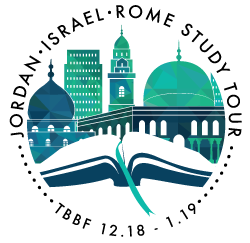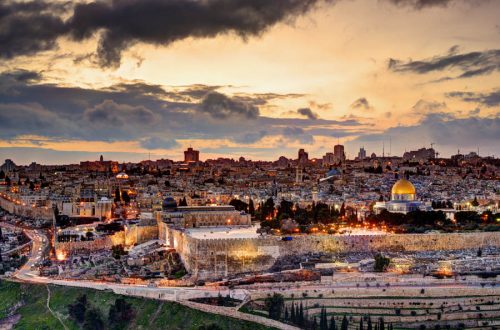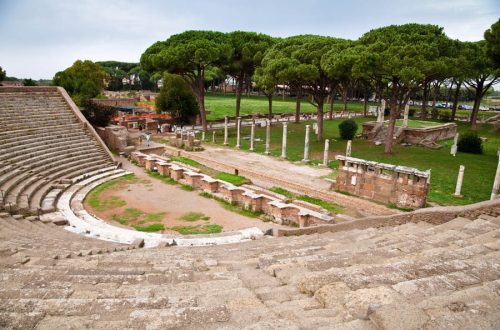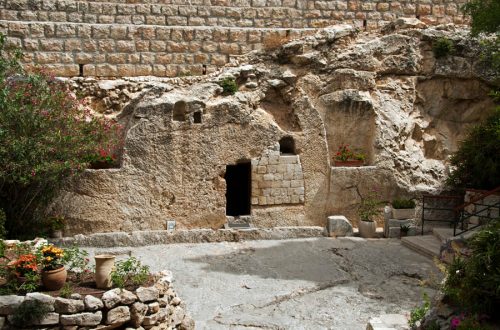Western Wall

Judaism’s holiest place is the Western Wall in the Old City of Jerusalem. Part of the retaining wall erected by Herod the Great in 20 BC to support the vast plaza on which he rebuilt the Temple, it is venerated as the sole remnant of the Temple.
The wall and the plaza in front of it form a permanent place of worship, a site of pilgrimage for Jews and a focus of prayer — often petitions written down and placed between the huge stones. The Jewish name for the wall is the Kotel.
 Orthodox Jewish men, fully bearded and garbed in black, bowing their heads as they read and pray from the Torah, are a common sight. It is also the place where Jews down the ages have expressed their grief over the destruction of the Temple, their anguish giving the wall another name — the Wailing Wall.
Orthodox Jewish men, fully bearded and garbed in black, bowing their heads as they read and pray from the Torah, are a common sight. It is also the place where Jews down the ages have expressed their grief over the destruction of the Temple, their anguish giving the wall another name — the Wailing Wall.
In the exposed part of the Western Wall today, the seven lowest layers of stones are from Herod’s construction. Most of these stones weigh between two and eight tons. Above these are stones placed in later centuries, replacing those forced out when the Romans put down a Jewish revolt by sacking Jerusalem and destroying the Temple in AD 70.
To the right of the plaza, near the southern end of the Temple Mount, large stones jutting out of the wall are the remains of what is called Robinson’s Arch. This arch once supported a grand staircase to the Temple. In the time of Christ a deep valley, spanned by bridges, ran beside the Western Wall and eight more levels of stones were visible. Through the centuries this valley, the Tyropoeon, has been progressively filled in with masonry and rubble.
Mark 13:1 recounts that one of Jesus’ disciples exclaimed to him as they left the Temple: “Look, Teacher, what large stones and what large buildings!” Jesus replied: “Not one stone will be left here upon another; all will be thrown down.”
The Western Wall was captured by Jordan during the 1948 Arab-Israeli War and recaptured by Israel during the 1967 Six-Day War. Arab housing and mosques near the wall were immediately razed. In their place, today’s plaza was created, stretching from the wall to the Jewish Quarter.
At the left end of the Western Wall is the entrance to a tunnel which allows visitors to walk along 500 metres of the extended wall, under buildings of the Old City. Sights include the biggest stone in the wall, estimated to weigh 570 tons.
(from seetheholyland.net)
Rabbinical Tunnel

The tour of the western wall tunnels is one of the most popular tourist sites in Jerusalem. These underground tunnels connect the western wall prayer area to the north-west side of the temple mount, passing along the side of the temple mount and under the present day houses in the Old City. Along its path are remains from the second temple period, as well as structures from later periods.
The experience of walking along the tunnels is like taking a time machine back to the time of the second temple.
(from bible walks.com)
St. Stephen’s Gate

This gate is so named because of the tradition that the first Christian martyr was stoned outside this gate. Lions’ Gate is another name for this eastern entrance into the Old City because of the four animals that decorate the gate’s facade and reportedly placed there because of a dream of the builder Suleiman.
St. Anne’s Church

The Church of St Anne is the best-preserved Crusader church in Jerusalem. It marks the traditional site of the home of Jesus’ maternal grandparents, Anne and Joachim, and the birthplace of the Virgin Mary. The New Testament says nothing about the birthplace of Mary.
However, an ancient tradition, recorded in the apocryphal Gospel of James which dates from around AD 150, places the house of her parents, Anne and Joachim, close to the Temple area. The Church of St Anne is renowned for its remarkable acoustics and reverberating echoes.
The voices of even a small choral group can sound like a large congregation in a vast cathedral. Unlike other churches in Jerusalem, St Anne’s was not destroyed after the Muslim conquest in 1189. Instead, it was turned it into an Islamic law school by the sultan Saladin, whose name appears in the Arabic inscription still above the main entrance.
(from seetheholyland.net)
Pools of Bethesda
Archaeology has enabled a pool at Bethesda in Jerusalem to be identified as the scene of one of Jesus’ miracles. This was the healing of the paralyzed man who had waited for 38 years for someone to help him into the pool “when the water is stirred” — an event believed to have curative powers. The Gospel account says Jesus told the man, “Stand up, take your mat and walk”, and immediately he was made well (John 5:2-18).
The location of the Pools of Bethesda — actually a series of reservoirs and medicinal pools — is in the Muslim Quarter of Jerusalem’s Old City, north of the Temple Mount and about 50 metres inside St Stephen’s or Lions’ Gate. At that time, the gate was called the Sheep Gate, because this was where sheep were brought to the Temple for sacrifice.
According to an ancient tradition, Bethesda is also where Jesus’ maternal grandparents, Anne and Joachim, lived — and where his mother Mary was born. The Church of St Anne, built around 1140, stands nearby.
(from seetheholyland.net)
Model of Jerusalem

This is an outdoor scale model of the ancient city at the Israel Museum. The time is set in AD 66, the fateful year the Great Revolt against the Romans erupted, resulting in the destruction of the city and the Temple built by Herod the Great. All that’s missing from buildings of Jerusalem limestone are the people.
The crucifixion of Jesus Christ was only 36 years before, and the mound of Calvary can be seen just outside the Second Wall. The ancient city was then at its largest, more than twice the size of the present Old City.
Construction of the Model of Ancient Jerusalem was undertaken in the 1960s by Hans Kroch, owner of the Holyland Hotel, in memory of his son Jacob, who was killed in the 1948 Arab-Israeli War. The model covers nearly 4000 square meters, using a scale of 1:50.
(from seetheholyland.net)
Shrine of the Book
The Shrine of the Book is a wing of the Israel Museum in western Jerusalem. It holds all seven of the scrolls found in what is called Cave 1 at Qumran, near the Dead Sea. They are Isaiah A, Isaiah B, the Habakkuk Commentary, the Thanksgiving Scroll, the Community Rule (or the Manual of Discipline), the War of the Sons of Light against the Sons of Darkness (or the War Rule) and the Genesis Apocryphon. All are in ancient Hebrew except the last, which is in Aramaic.
The uncovering of the Essenes’ literary treasure trove has thrown new light on Israel during the Hellenistic and Roman periods, as well as on the origins of rabbinical Judaism and the Jewish society in which Christianity began. The discovery, by a Bedouin goat- or sheep-herder searching for a missing animal, occurred in 1947. Israel was on the eve of its War of Independence, a factor that lent a cloak-and-dagger character to negotiations for the purchase of the scrolls.
(from seetheholyland.net)
Related Biblical References:
- 1 Kings 5-6 – Solomon builds the temple
- Mark 13:1-8; Matt 24:1-2 – Jesus foretells the destruction of the Temple
- Acts 6-7 – Stoning of Stephen
- John 5:1-16 – Healing at the pools on the Sabbath






